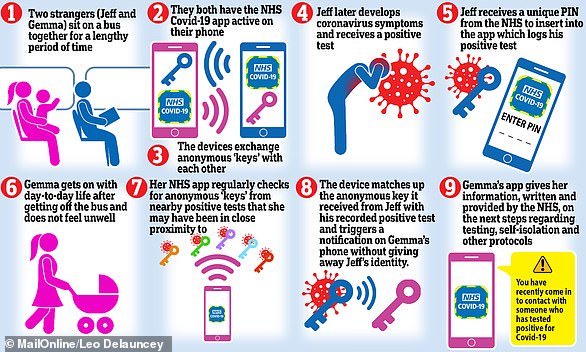NHS Covid app ‘may WRONGLY tell a THIRD of users to self-isolate’ after incorrectly reading 2m social-distance – as it emerges more than three million Britons with iPhone 6 or older models CAN’T download it due to iOS issue
- Risk of false positives stems from the app’s reliance on Bluetooth signals
- Government insists the new app is as accurate as its counterparts abroad
- Matt Hancock today urged people to download it to help fight against Covid
The new NHS Covid app may wrongly tell up to a third of its users to self-isolate after incorrectly thinking they have come close to an infected person – while millions of Britons won’t be able to access it if they have an iPhone 6 or older.
The risk of false positives stems from the app’s reliance on Bluetooth signals, which can be affected by nearby objects.
This means the app could judge that its user has come within two metres of an infected person for more than 15 minutes when they were actually just close to a Bluetooth-emitting object.
This issue raises the risk of people deleting the app because they think it is not working properly, or simply deciding not to download it.
Those who receive false positives may also try to access testing centres, leading to more pressure on the already struggling service, or they could ignore the direction and risk a £10,000 fine for failing to self-isolate – despite not actually having the disease.
Officials say the app’s accuracy matches that of other countries, and downplayed hopes for the contact tracing function. They said its main benefit will be to encourage people to abide by social distancing and hygiene rules, The Times reported.
Health Secretary Matt Hancock this morning urged Britons to download the software to ‘make the country a safer place’, as he revealed almost 10,000 people a day are contracting Covid.
But it emerged today that the app cannot be accessed on the iPhone 6 or older models, with social media users sharing their attempts to add it to their phones only to see an error message saying it required iOS 13.5 or later.
This Apple operating system can only be downloaded on the iPhone 6S and newer models – excluding any handsets that are more than five years old.
The app – which has arrived four months late – can also be used on Android phones, where it appears to be working with no issues.
But millions of iPhone users are now set to be excluded from the service, which Age UK warned would include many elderly people who tend to have older phones.
Caroline Abrahams, the charity’s director, told MailOnline: ‘It’s unfortunate that you will need a relatively new smartphone to use the NHS App since many people of all ages don’t have one, older people especially.
‘When you add in the very significant numbers of older people who don’t own a smartphone at all, the upshot is that the NHS App seems likely to pass much of the older population by.’
The app was first tested on the Isle of Wight using the same iPhone software, so officials would have been aware that many devices were unable to download it before it was rolled out on the mainland.
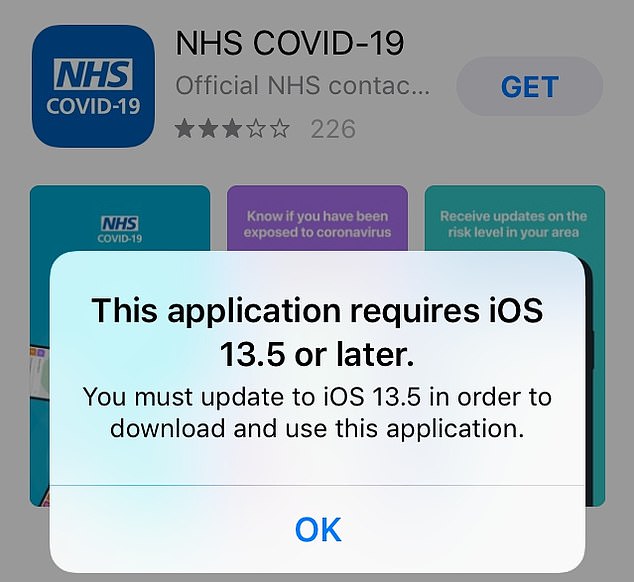
A screenshot showing an attempt to download the app on an iPhone 5C, which prompted a message saying the software was out of date




Social media users shared attempts to download the app on their iPhones only to see an error message saying it required iOS 13.5 or later
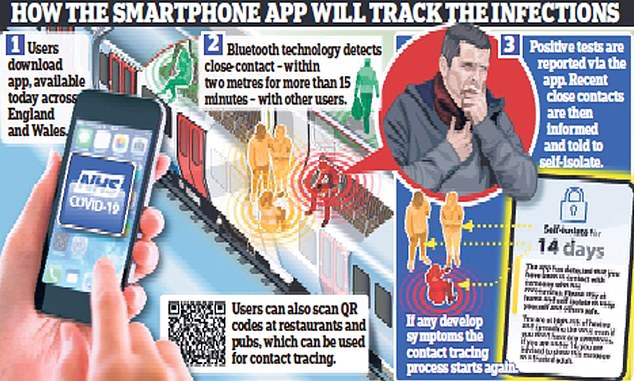
The app uses Bluetooth technology to alert users if they have come into contact with someone who has tested positive for the virus
Britons are being urged to use the app after it finally being launched nationwide today, with officials hoping it will play a crucial role in containing the virus at a critical point, when cases are on the rise again.
The Department of Health will tonight launch a major TV advertising campaign to increase uptake by urging the public to ‘protect your loved ones, get the app’.
Officials hope that between 15 and 50 per cent of the population in England and Wales will use it.
Scotland and Northern Ireland have already launched their own versions.
The app uses Bluetooth technology to alert users if they have come into contact with someone who has tested positive for the virus such as on public transport, in a shop or among their friends and family.
They will then receive a message telling them to self-isolate for 14 days and to book a test, although only if they develop symptoms.
The device will also enable users to check their symptoms online if they are worried they might have the virus and to book a test if necessary.
Additionally, they will be encouraged to use their apps to scan the ‘QR code’ at any pubs, restaurants and leisure centres they visit in case there is a virus outbreak linked to that venue.
Their contact details will then be available for tracing efforts.
Health Secretary Matt Hancock today urged people to download the software to ‘make the country a safer place’.
‘You download the app you will also have that added protection for you and your loved ones,’ he told Sky News.
The app, which uses a system developed by Apple and Google, has been tested on the Isle of Wight and in the London borough of Newham.
Apple regularly updates its operating system and restricts apps from using older software, meaning people with older iPhones can find themselves unable to download newer apps.
This issue affects the new Covid tracing app too, with anyone using an iPhone 6 or any older model unable to use it.
Recent data from the technology company Statista suggests 3.8% percent of UK smartphone users have an iPhone 6, so with nearly 80million smartphone users nationwide this means there are more than three million people who own that model alone.
The app was meant to have been launched in the middle of May but Health Secretary Matt Hancock was forced to abandon the technology after it failed to work on the majority of smartphones.
Yesterday Mr Hancock said: ‘We are at a tipping point in our efforts to control the spread of this virus.
‘With infection rates rising we must use every tool at our disposal to prevent transmission, including the latest technology.
‘Today’s launch marks an important step forward in our fight against this invisible killer and I urge everyone who can to download and use the app to protect themselves and their loved ones.’
Government officials aren’t setting a target for the percentage of the population they want to download the app.
But Oxford research has shown that even if just 15 per cent use it, then there could be a significant reduction in positive cases, hospital admissions and even deaths.
The Department of Health admits the technology still struggles to calculate precise distances, which means some users may be wrongly told to self-isolate even if they have been more than two metres away from an infected person.
Close contact is defined as being within two metres of someone for 15 minutes, but in early trials of the app some people have received alerts when they were four metres away.
Officials say that about 30 per cent of people told to self-isolate may have been more than two metres away from a positive case but they stress the difference is marginal and the majority are still likely to have still been 2.1 or 2.2 metres away.
They insist the technology is far more precise compared with other apps used elsewhere in the world, although they admit there is ‘more work that could be done’ to improve it.
Baroness Harding, executive chairman of the NHS Test and Trace Programme, said: ‘We want to make it as easy as possible for everyone to engage with England’s NHS Test and Trace service. This is a welcome step in protecting those around us.’
Last night Department of Health officials acknowledged the app would increase pressure on the country’s testing services but they said the capacity was increasing, and demand from other members of the public was falling.
Last week Boris Johnson was forced to admit that the country had run out of tests following a surge in people trying to book them, partly brought about by children going back to school and spreading bugs.
To encourage the public to download the new version, emotive TV adverts will be broadcast at 7pm tonight with personal stories from families affected by the virus.
Professor Andrew Goddard, president of the Royal College of Physicians, said the app must be ‘fit for purpose’.
Today, NHS Test and Trace said 19,278 new people tested positive for Covid in England between September 10 and September 16.
Britain reported 6,178 new daily cases, the highest number of infections since May 1, but it has increased testing capacity since then.
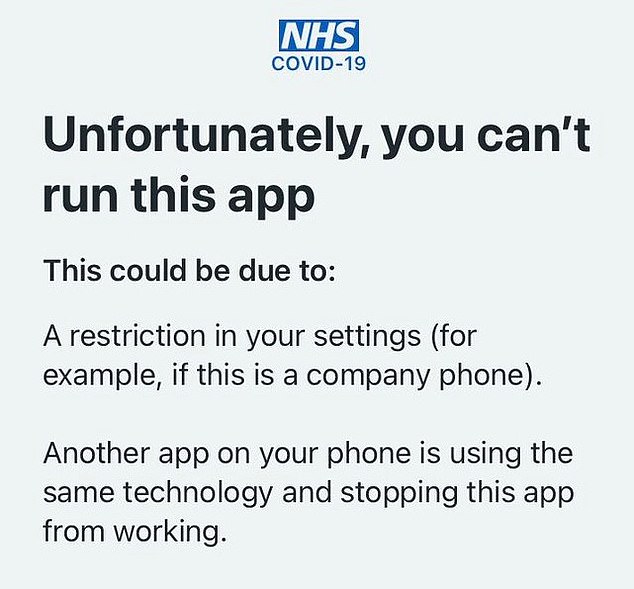
Another error message some users have been getting from the app, including if they try to use it on a company phone
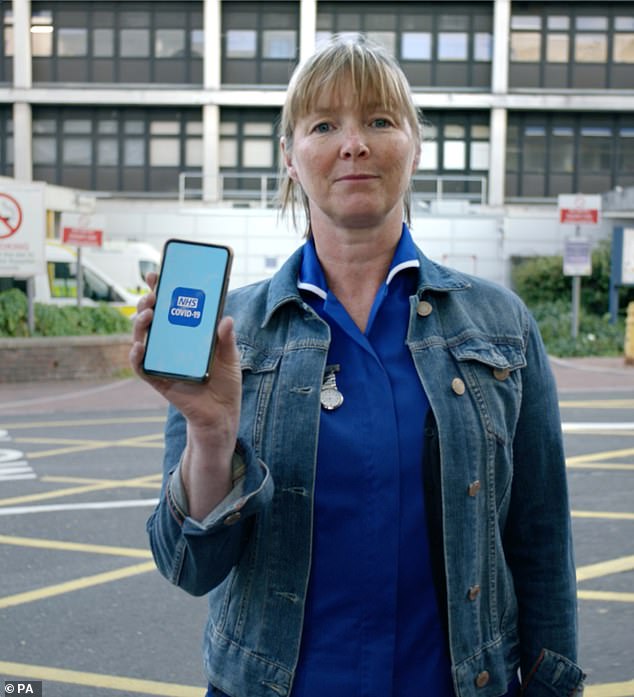
Health officials hope it will play a crucial role in containing the virus at a critical point, when cases are on the rise again. Pictured: A Department of Health handout
Google Maps now shows coronavirus outbreaks in your region using a colour-coded layer to highlight number of cases
Google Maps is adding a new layer that gives users update information on coronavirus outbreaks in a selected region.
The new feature comes on the heels of other coronavirus-related updates to Maps, including info on crowdedness, COVID-19 transit alerts and travel restrictions.
Users tap the ‘layers’ button on the right hand corner of the map and click on ‘COVID-19 info’
A seven-day average of new infections per 100,000 people will appear, as will a label indicating whether the cases are trending up or down.

A new layer on Google Maps allows users to see details on COVID-19 outbreaks in a given region, like the Florida Heartland (seen here). Seven-day averages are presented, along with a label indicating whether the number of infections is trending up or down
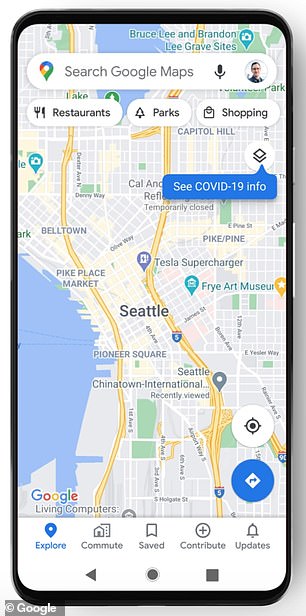

Google Maps users can tap on the ‘layers’ button on the right hand corner of a map and click on ‘COVID-19 info’. The feature is available on the country level worldwide, and for cities, states and municipalities where available
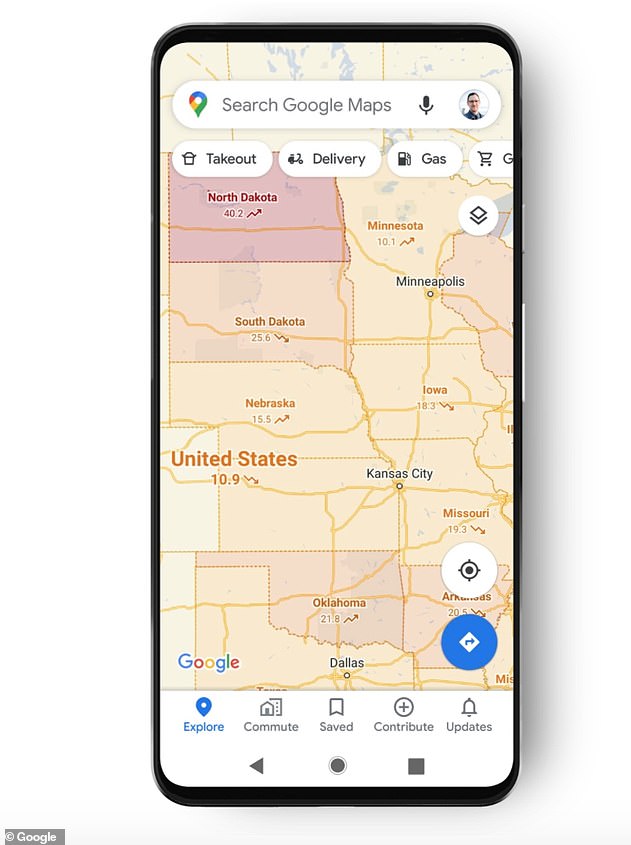
Google Maps’ COVID-19 layer for the Central United States. Color coding indicates the density of new cases, from grey (zero cases) to dark red (more than 40 cases per 100,000 residents)
Colour coding on maps indicates the density of new cases: Grey indicates no cases in a given region, with yellow representing 1-10 cases, orange 10-20, dark orange 20-30 cases, red 30-40 cases, and dark red indicating more than 40 cases per 100,000 residents.
The COVID layer starts rolling out worldwide this week on Android and iOS.
Trending data is visible at the country level for all 220 countries and territories that Google Maps supports, the company said, along with state, county, and city-level data where they’re available.
Google says the figures come from multiple sources – including Johns Hopkins, Wikipedia, and the New York Times- that are in turn pulling data from medical centers, state and local governments, and the World Health Organization.
‘Many of these sources already power COVID case information in Search, and we’re now expanding this data to Google Maps,’ said Google Maps product manager Sujoy Banerjee in a blog post on Wednesday.
‘Our hope is that these Google Maps features will help you get where you need to be as safely and efficiently as possible.’
In June, Google Maps began including details about public transit routes being impacted by the pandemic.
It also added driving alerts to notify motorists about COVID-19 checkpoints and restrictions along their route, including when crossing international borders.
Google Maps now also includes health facilities near users that support COVID-19 testing, with an alert reminding users to verify eligibility and facility guidelines to avoid being turned away ‘or causing additional strain on the local healthcare system.’
In some regions, users can also see which restaurants offer delivery and carry out.
This month Google partnered with Apple on contact-tracing software using Bluetooth to alert people if they have been in close proximity with someone diagnosed with COVID-19.
Users can decide whether they want to declare they have tested positive, as well, using a unique PIN to keep their identity anonymous.
Google Maps tackled another national crisis this summer when it added a wildfire boundary map providing the near-real-time outline of a conflagration a traveler may encounter, with directions to current news and helpful information from local authorities.

